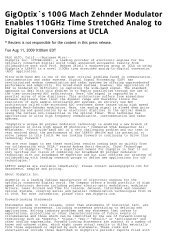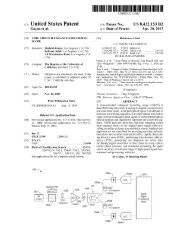First silicon laser pulses with life - jalali-lab @ ucla
First silicon laser pulses with life - jalali-lab @ ucla
First silicon laser pulses with life - jalali-lab @ ucla
Create successful ePaper yourself
Turn your PDF publications into a flip-book with our unique Google optimized e-Paper software.
nature physics portal - research highlights - Fi...http://www.nature.com/physics/highlights/7013-1.html<br />
1 of 2 5/30/2013 3:52 PM<br />
<strong>First</strong> <strong>silicon</strong> <strong>laser</strong> <strong>pulses</strong> <strong>with</strong> <strong>life</strong><br />
Mark Peplow<br />
Key component in optical computing unveiled.<br />
© Nature<br />
Publishing Group<br />
2004<br />
It may be small, but it could be very influential. Scientists have created<br />
the world's first <strong>laser</strong> made from <strong>silicon</strong>. This is an important step in the<br />
effort to build computers that process information using light, rather than<br />
electricity.<br />
Although much of the data in the world is now carried by light along<br />
optical fibres, the information processing and handling is usually still done<br />
after converting the signals into electrical currents, which are easier to<br />
manipulate. This conversion slows the whole process down, and also<br />
requires extra components, raising the cost of the circuitry.<br />
So scientists have been striving to make devices that can process light<br />
directly. Silicon is preferable because it can be mass-produced using<br />
conventional chip-making techniques. Unfortunately, it is also very poor at<br />
controlling light. Conversely, materials such as gallium arsenide, which are<br />
great at dealing <strong>with</strong> light, are very difficult to make into chips.<br />
Silicon<br />
<strong>laser</strong>s<br />
bring<br />
us<br />
closer<br />
to<br />
chips<br />
that<br />
can<br />
process<br />
light.<br />
"There have been many attempts, but no-one has been able to get <strong>silicon</strong> © Getty<br />
to lase before now," says Bahram Jalali, an electrical engineer at the University of<br />
California, Los Angeles. Jalali and his UCLA colleague, Ozdal Boyraz, have published<br />
their research online in the latest edition of Optics Express.<br />
Making a <strong>silicon</strong> <strong>laser</strong> is widely regarded as one of the main hurdles that need to be<br />
overcome before optical computing can become a reality, says Leigh Canham, of<br />
pSiMedica, a company based in Malvern, UK, that researches the clinical<br />
applications of <strong>silicon</strong> nanocrystals.<br />
"A few years ago people thought that any form of lasing in <strong>silicon</strong> was impossible,"<br />
says Canham, who was the first to show that <strong>silicon</strong> nanocrystals could emit visible<br />
light, when he worked for the technology company QinetiQ, based in Farnborough,<br />
UK. "This work is an important proof of principle. I believe it does bring us closer to<br />
optical computing."<br />
Dynamite <strong>with</strong> a <strong>laser</strong> beam<br />
Lasers are useful for carrying out optical calculations because all the packets of<br />
light they produce have the same wavelength, and are precisely marshalled to<br />
maximize the amount of energy they deliver in a tight beam.<br />
To make a good <strong>laser</strong>, you need a material that can take an energy input and turn it<br />
into light energy in a regular rhythm. But <strong>silicon</strong> has always been problematic<br />
because it loses much of this energy as vibrations <strong>with</strong>in its atomic lattice. Jalali<br />
and Boyraz's breakthrough makes a virtue of this, using the vibrations themselves<br />
to generate <strong>laser</strong> light. "Our approach uses the natural atomic vibrations of <strong>silicon</strong><br />
to create or amplify light," says Jalali.<br />
But it will be a few years yet before <strong>laser</strong> beams are whizzing about inside your<br />
desktop computer . Rather than turning electricity directly into light, Jalali's <strong>silicon</strong><br />
<strong>laser</strong> is powered by another <strong>laser</strong>. It's a common method of investigating new <strong>laser</strong><br />
materials, but the jump to electricity will definitely have to be made before the<br />
<strong>silicon</strong> <strong>laser</strong> can be used in an optical computer, says Jalali. They also need to<br />
develop the <strong>laser</strong> into a self-contained component that can be incorporated on to a<br />
<strong>silicon</strong> chip.
nature physics portal - research highlights - Fi...http://www.nature.com/physics/highlights/7013-1.html<br />
2 of 2 5/30/2013 3:52 PM<br />
References<br />
1.<br />
Boyraz O. & Jalali B. Opt. Express, 12. 5269 - 5273 (2004).<br />
< previous article | all this week's articles | next article ><br />
© Nature Publishing Group 2004 - NATURE NEWS SERVICE








